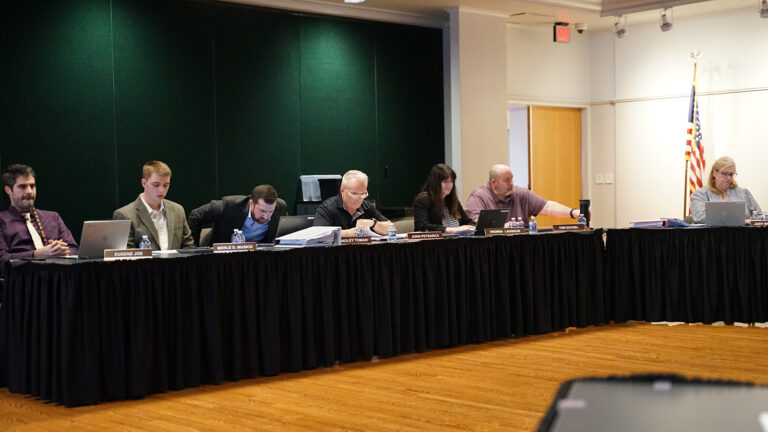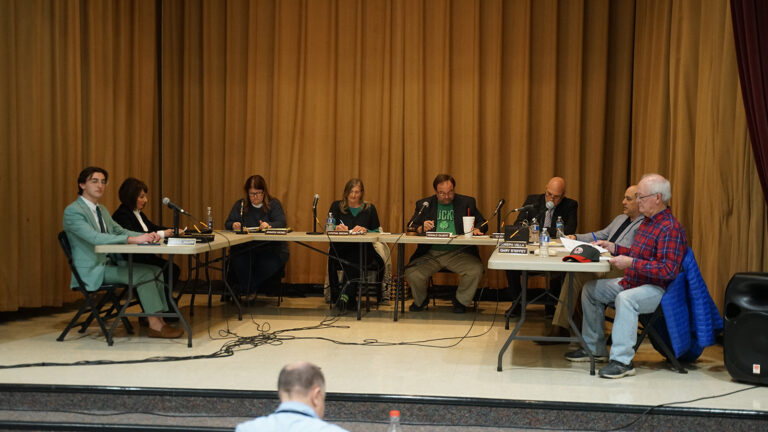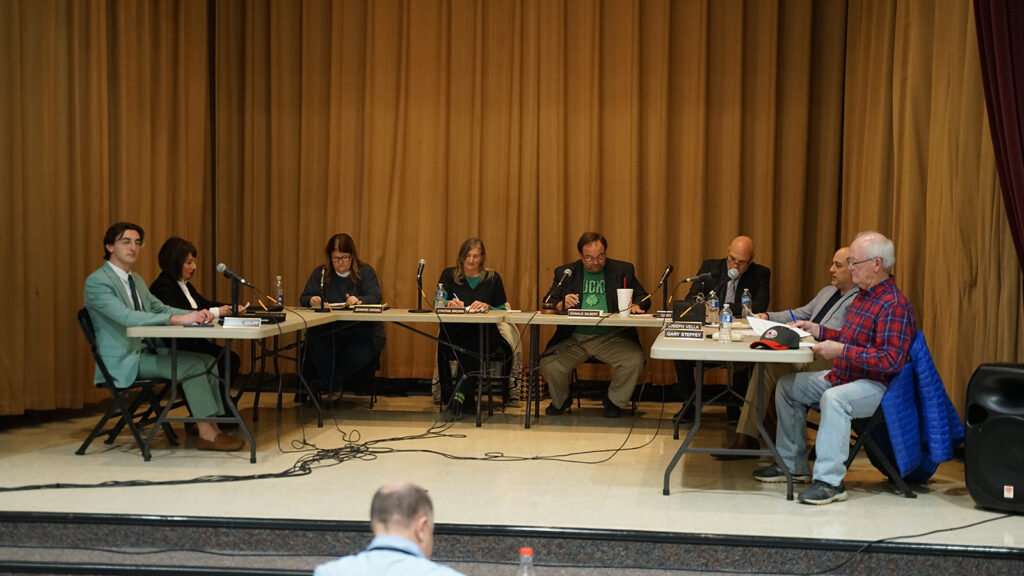SHP will create new junior high school roof design

While it first looked like it would be another month before anything happened with the junior high roof project, the Greater Latrobe School District Board of Education Tuesday approved putting it out for bid.
The school board voted 6-3 to hire SHP as the architect to design and oversee a new roof for the junior high school. School Directors Merle L. Musick, Merle D. Musick and John Petrarca all voted against the SHP proposal.
SHP’s work will cover the initial design and review of bid documents from potential contractors, along with site visits during construction and review of the completed work and approval of final payment. SHP will be paid $365,000 for its services and the roof is expected to be completed by Sept. 15, 2026.
Some of the work can be completed during the school year, but the district’s Director of Facilities Kurt Thomas said he prefers to keep the “heavy work” confined to the summer months minimize disruptions.
The district is still in talks with Siemens about upgrades to its HVAC system. The district had hoped to tackle both projects at the same time as to not have one interfere with the other. That may still be possible, but if not, Thomas said safeguards will be put in place to protect the roof.
The district has struggled with poor design choices for the 137,000-square-foot roof since its construction back in the 1970s. Over the years, heavy snow and freezing temperatures have worsened the problem by blocking drains, causing water to overflow behind metal walls and create leaks. Severe winter weather in January led to tarps and buckets being placed around the school to capture incoming water.
Thomas said the roof at the junior high school is still in good condition. Water is not leaking directly in from the roof nor is it caving in as some people have claimed, Thomas said. While there is moisture in parts of the roof, a recent mold study found none in the junior high school.
Thomas added that while water issues do pop up the junior high school is “relatively dry” most of the time. Snow and rain events, including storms that rolled through the area Sunday caused no issues.
“It’s not that we are leaking every time it rains,” Thomas said. “It’s when we come into these winter time periods that we have issues.”
The board of education has gone back and forth for months on what to do with the roof and the junior high school. Newer board members elected on a mandate of no new schools have said they want to take care of what the district has now instead of mass construction and renovation projects. But other school directors have said they want to put a building plan in place before spending large amounts of money on construction.
Two years ago, the board of education approved an SHP-developed plan to consolidate its footprint while constructing new school buildings better suited for modern learning. That multi-phase plan also came with a price tag closing in on $200 million.
On Tuesday, Petrarca voiced his concerns for the additional price hiring SHP would have on the project.
“I do not think that SHP is necessary for their services,” Petrarca said. “The companies that are the manufacturers of the roofs, were going to get bids for those. They have engineering firms on them.”
Petrarca pointed to the senior high school roof that was replaced about six years ago. At the time, the district chose a process that allowed them to work directly with the roof manufacturer. That process did not require a third-party architect to draw up design work nor oversee the project but it also did not allow for an open bidding that would have potentially got the district a cheaper price.
The district’s business administrator Dan Watson, explained that there are different ways the school district can pursue the construction project but there are set rules for both.
The two options the district has considered is utilizing a co-op service and the competitive bid process.
Through the bid process, the district must outline project requirements and provide specifications and drawings to interested bidders. Those standards cannot deviate from one business to another. After the bids come in, the school board could either accept the lowest responsible bid or toss out all the bids and decide on next steps.
As for the co-op process, school districts and other municipal governments can utilize a service like the state’s COSTARS program and work directly with a manufacturer at a price agreed upon through the vendor. Using this process typically speeds up the procurement process because the entity is not waiting for bids to be received, reviewed and approved, which can take weeks.
“I would say is that if you go through a true competitive process, you’re going to have a public bid opening where you’re going to see what the market is offering,” Watson said. “If you go through a co-op … you’re not going to be sure you’re getting the best price by going through that co-op.”
Watson added that the co-op process is typically used in emergency situations and when the district wants to work with a “known commodity,” like The Garland Company.
It’s also the initial process that Petrarca proposed back in February which was subsequently approved by the board of education.
But at a facilities committee meeting earlier this month, Petrarca had asked the committee if any other roofing companies had reached out about the project. One did, which led to Petrarca and others asking for the district to seek bids for the roof.
Last week during the Committee of the Whole meeting and after a presentation by SHP, Petrarca and others called for SHP’s proposal to be removed, ultimately leading to Petrarca’s Tuesday request that the board work directly with a manufacturer.
SHP’s lump sum payment would equal about 3.5% of the estimated roof project cost of $8.1 million. Petrarca said that he wanted to see the district save that money as the manufacturers provide their own architect. But Watson and others cautioned that if the district went the co-op route, the savings would be null due to estimated mark-up costs.
“There’s a three and a half percent markup in their own materials, like cost per lineal foot, those sorts of things,” Watson said. “Doesn’t mean that’s the price for a bid yet, we can negotiate it, but there’s no way of knowing if it’s the cheapest price we can get, unless we go through a true competitive process.”
Josh Predovich, an architect and director of master planning at SHP, said the company is ready to move forward quickly to design a better roof and get those specifications out to companies for bids.
SHP has worked with several school districts over the past few years including Greater Latrobe and Derry Area. Predovich said the company has completed more than $3 billion in construction projects for its K-12 customers over the last 10 years. Those projects are a mix of new construction and renovation projects, with most having roof work as part of the scope, he said.
“We’re very comfortable working on roofing projects, re-roofing projects, even with buildings that are as complex as the junior high,” Predovich said. ““I think the one thing that really didn’t get talked about a lot tonight is this isn’t just a simple re-roof, right?
“We’re going to improve what’s there. If we just go back in with what’s there, exactly the same configuration, exactly the same detailing, then you’re going to have the same issues again.”
Predovich said the biggest design challenge is addressing a slight slope — a difference of one-eighth to one-quarter of an inch — that causes water pooling. When the water freezes, drains become blocked and water spills over in between the wall panels.
Predovich said he thinks the solution may be to install crickets – triangular- or diamond-shaped material designed to force water to the drains so pools don’t form and ultimately freeze. SHP will also look at redesigning the wall panel system as well.
Predovich added that roofs now typically come with a 30-year warranty, something the school board previously pursued when it wanted to go the co-op route last month.
Kurt Thomas, director of facilities for GLSD, said after the meeting that while warranties are great, they’re more of an insurance policy than a testament to how good a product will be.
“It’s what companies are willing to take your price for buying their roof with all the roofs they have in the nation, and the nerds and accountants they’re like, ‘We can cover this type of roof system for 30 years, 20 years, whatever it may be. They’re project specific a lot of times. A warranty doesn’t tell you it’s a better performing roof. It doesn’t tell you that the roof is going to fail within that time period.”
Thomas said that maintaining a roof beyond its warranty period is a testament to the type of roof the district put on. The roof on the junior high school is now six years past its 20-year warranty period.
The district has worked to maintain the roof including large and small repairs, scans and conducting bi-annual inspections in order to maintain its longevity, Thomas said. He didn’t have exact numbers but said the district has spent six figures maintaining the roof over the past six years.
Thomas added that while the roof has required maintenance, past failures were attributed to the panel system.








